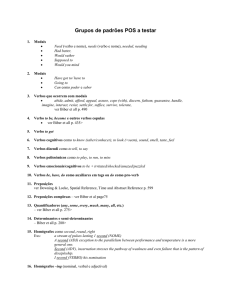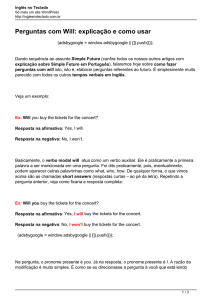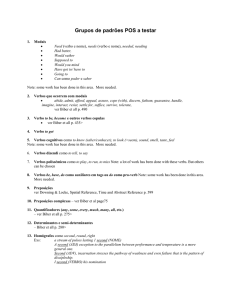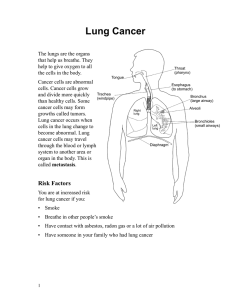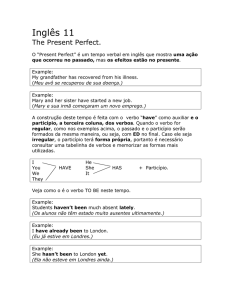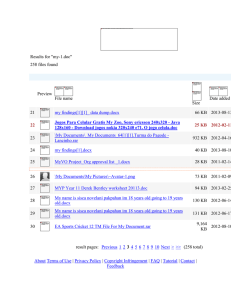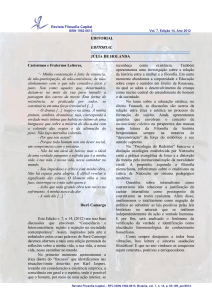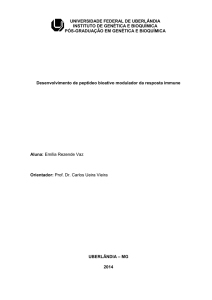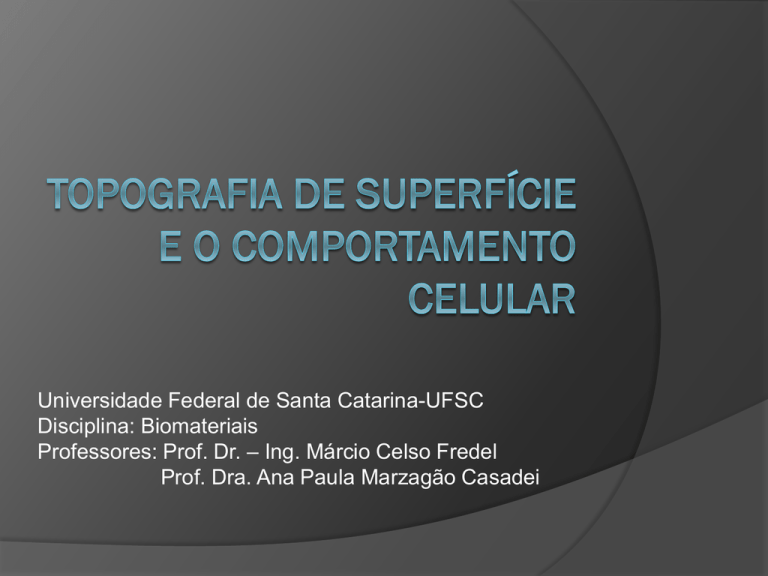
Universidade Federal de Santa Catarina-UFSC
Disciplina: Biomateriais
Professores: Prof. Dr. – Ing. Márcio Celso Fredel
Prof. Dra. Ana Paula Marzagão Casadei
Introdução
Com o aumento do uso de materais artificiais
em medicina, compreender qual estímulo
promove a reação celular desejada no tecido
adjacente para melhorar a performance do
implante, ainda é um desafio.
Dois aspectos importantes, interferem com a
resposta celular:
A química de superfície
A topografia da superfície
A reação celular frente à topografia
da superfície
Dirigir a migração celular é essencial para o
desenvolvimento do tecido. O movimento da
célula de uma parte para outra deve estar sob
controle.
A interação célula-célula tem um papel chave
no controle da migação.
A possibilidade da química da matriz extra
celular ou de gradientes quimiotáticos
inteferirem no proceso, devem ser
considerados.
Microfabricação e a definição de
ceracterísticas de supefície
Utilizando-se métodos aproveitados da tecnologia de
fabricação microeletrônica, é possível construir
superfícies com estrutura perfeitamente definida,
permitindo estudar o comportamento celular frente à
diferentes superfícies.
Materiais sintéticos como silício, vidros e metais
como titânio e suas ligas, têm permitido construir
superfícies com características topográficas
precisas, como cristas e sulcos.
Dependendo do espaço, as células podem se
acumular sobre as cristas, extendendo-se ao longo
delas, em um fenômeno chamado “ridges walking”.
Processo de fotolitografia
Fig. 1 Schematic representation of the photolithography process. The target surface (1)
is cleaned and resist applied to the target material (2). A photomask is then created
and developed onto the substrate (3), through the mask (4). The substrate is then
etched (5), and the resist is removed using acetone (6), leaving the desired topography
etched onto the substrate.
Tipos de topografia de superfície
Fibras
Sulcos repetidos
Covas ou buracos
Túneis ou tubos
Substratos descontínuos
Superfícies rugosas
Fibras
Podem ser produzidas usando-se materiais
como titânio, PGA, PLA, Polipropileno,
Quitosana, vidros, colágeno, etc.
Avanços na fabricação de fibras permite:
Criar fibras de comprimento e diâmetros
controlados, formar malhas,
Criar estruturas porosas sem perder as
propriedades mecânicas do material capazes de
promover a migração e o crescimento celular
Túneis e tubos
Vários tipos de células vivem ou formam
estruturas tubulares.
É necessário estudar o comportamento
celular em superfícies concavas e
convexas.
Substratos descontínuos
Tradicionalmente tem-se utilizado a estrutura
de bordas contínuas para guiar a migração
celular.
Atualmente tem-se estudado o
desenvolvimento de superfícies com bordas
descontínuas.
Investigações utilizando-se fibroblastos e
células epiteliais têm demonstrado que a
descontinuidade entre bordas, parece
favorecer a migração e o crescimento celular.
Superfícies rugosas
São definidas como sendo de topografia
produzidas aleatoriamente, a fim de aumentar a
área de contato entre o tecido e o implante.
Medida por um índice de rugosidade – Ra.
Técnicas
Jateamento
Plasma spraying de titânio
Ataque ácido (Ác. Nitrico e ac. Fluorídrio)
Nanotopografia e microtopografia
Caracterizada pela presença de pilares
ou buracos em escala semelhante ao
tamanho das moléculas como colágeno
e outras matrizes extra celulares.
O objetivo é um bom ancorameto
mecânico entre o tecido e o implante.
Representative images of surface
topographies
(A) Epithelial cells growing on fibers,
(B) actin staining of mesenchymal
stem cells growing on repeating
grooves,
(C) P388D1 macrophages growing in
cell traps,
(D), rat calvarial osteoblasts growing
in ‘‘pit’’-type topographies,
(E) fibroblasts growing on a convex
topography,
(F) ovine chondrocytes cultured in
240 mm-diameter quartz tube,
(G) microtubule staining of human
gingival fibroblasts growing on a
discontinuous edged topography,
(H) human gingival fibroblasts
cultured on SLA roughened titanium.
Cell Types Sensitive to Topography
Comportamento celular e a
topografia da superfície
Adesão
Alinhamento e orientação
Guia por contato
Guia por gap
Adesão
Via de regra, a topografia da superfície
influencia a adesão celular, porém a natureza
e a extensão dessa influência depende do tipo
de célula envolvido e das dimensões da
topografia.
Superfícies rugosas favorecem a adesão de
algumas células, como osteoblastos e
dificultam a adesão de outras, como
fibroblastos, que preferem superfícies lisas.
As diferentes respostas celulares, permitem
usar diferentes superfícies para selecionar o
tipo de célula que se deseja favorecer em
determinados locais.
Alinhamento e orientação
No interior de alguns tecidos, a arquitetura e o
arranjo celular é um fator importante na
determinação da função.
Alguns tecidos contam com a localização específica
da célula para produção da MEC, e em alguns casos
as células obedecem um padrão de alinhamento e
orientação espacial, como em tendões, ligamentos e
músculos.
Fibras e substratos com sulcos repetidos têm
mostrado bons resultados no alinhamento de células
e tecidos.
As células também variam em relação ao tempo de
resposta frente ao substrato. Em sulcos, macrófagos
respondem em 5 minutos, fibroblastos em 2 horas e
condrócitos em mais de 6 horas.
Guia por contato
Refere-se à tendência da célula de ser
guiada na sua locomoção por superfícies
contínuas, como bordas físicas, sulcos,
fibras ou outro tipo de estrutura
topográfica.
Algumas células mostram um padrão de
migração por contato com a superfície do
substrato, enquanto outras como
condócitos não mostram padrão de
alinhamento paralelo ao eixo de sulcos.
Gap guidance
Pesquias tem sido feitas para identificar
as possíveis respostas celulares frente
a substratos com superfícies
descontínuas.
Algumas células como fibroblastos
gengivais e células epiteliais de
ligamento periodontal tem apresentado
respostas favoráveis frente a superfícies
descontínuas.
Expressão genética de proteínas
Enquanto o comportamento celular
frente a diferentes topografias de
superfície tem sido bem estudados, as
alterações na fisiologia celular em nível
molecular permanecem obscuras.
Decifrar a expressão genética frente a
diferentes superfícies, requer a seleção
e análise de diferentes genes.
Introduction
With the increased use of artificial
materials in medicine, understanding
which stimuli promote desirable
reactions from cells in surrounding
tissues has become critical to improve
implant performance.
two key aspects have been identified
that influence cellular response,
the chemistry
the topography of the material.
SIGNIFICANCE OF
TOPOGRAPHICAL REACTION
Directed cell migration is essential during
development, where the movement of cells
from one part to another must be under
precise control.
cell–cell interactions and topography have
been identified as playing key roles in this
patterned migration.
The possibility that extracellular matrix
chemistry or chemotactic gradients could be
influential, can not be excluded.
IN VIVO APPLICATIONS OF
CELL—TOPOGRAPHY INTERACTIONS
Fibers
Since this time, fibers have been produced using materials
such as titanium, poly-glycolic acid, poly-lactic acid,
polypropylene, glass, chitosan, ceramics, as well as natural
materials such as fibronectin and collagen.
The advantages of fiber-based systems
be able to extrude the fibers to any length required as well as
being able to knit the fibers into meshes.
the ability to create a porous structure without any loss of
mechanical strength of the material, thus producing an implant
that is able to withstand physiological biomechanical stimuli as
well as promote cellular ingrowth.
Tunnels/Tubes
Several cell types within the body, such as endothelial
cells in blood vessels, live within tube-like structures.
There has, however, been only scant attention paid to the
response of cells to concave surfaces, in contrast to
numerous reports of cell response to convex surfaces.
Discontinuous Substratum
Traditionally, the theory of contact guidance centers
on the presence of a continuous edge, guiding a cell
in a specified direction.
The design of the discontinuous edged topographies
(DES) is such that essentially the topographies
comprised repeated open square boxes, with gaps at
each corner.
Investigations using fibroblasts and epithelial cells
have shown that DES topographies have great
potential to be used not only in vitro to investigate
cell guidance, but also in vivo to organize tissue
around percutaneous implants.
Roughened Surfaces
Surface roughness was defined as a randomly produced topography.The
rationale for using rough surfaces is that the contact area between the tissue
and the implant surface s increased, thus facilitating interaction between the
tissues and the device.
The most widely accepted characterization is the average vertical amplitude or
RA value, which is calculated from an average of the feature sizes. In general,
the higher the RA value,the rougher is the surface.
The simplest way of producing a rough surface is to rub the material with
abrasive particles.
Other techniques to produce rough surfaces include titanium plasma spraying,
which involves the coating of melted droplets of titanium onto the material
surface, which then cool to form protruding structures (RA value of ~5.85 mm).
Acid etching, commonly accomplished using an aqueous mixture of nitric acid
and hydrofluoric acid at a ratio of 10 : 1, results in a surface that has an RA
value of ~0.59 mm.
TYPES OF SURFACE TOPOGRAPHY
Microfabrication and Defined Surface Features.
With the advent of the use of techniques harnessed from the
microelectronic industry, it has become possible to produce structures with
precisely defined surfaces in cell biological studies, thus allowing the
reaction of cells to defined topographic features to be observed.
Synthetic materials such as silicon and glass, cellulose acetate, epoxy,
araldite, polystyrene and metals such as titanium and titanium alloys have
all been employed to produce precisely characterize topographies.
Using such methods of fabrication, fibers of glass can be drawn out to
precise dimensions, and structures such as ridges and grooves can be
made using photolithography and etching techniques in silicon.
Depending on spacing, cells responded by accumulating on the ridges and
extending along them. In some instances, the cells were guided in their
migration by the ridges, a phenomenon termed “ridge walking”.
Microfabrication and Defined
Surface Features
Nanotopography Vs. Microtopography
One area on which many research laboratories are currently
focused is the use of nanometric sized surface features,
such as pillars and holes.
The logic of using such small features is that they are in the
same size range as molecules such as collagen and other
extracellular matrix molecules that cells will encounter within
the body.
One desired reaction at the implant surface is good
mechanical interlocking, especially in bone contacting
regions, because a major cause of implant failure is
micromotion and friction at the tissue–implant interface.
CELL BEHAVIOR INFLUENCED BY
SUBSTRATUM TOPOGRAPHY
Adhesion
It has been long known that roughe surfaces generally promote
adhesion of some cell types such as osteoblasts, whereas cells
such as fibroblasts prefer smooth surfaces.
that surface topography influences cell
adhesion, although the nature and extent of the influences
depends on the cell type involved, as well as the dimensions of
the substratum topography.
The general rule to follow is
The differential response of cell types to topography opens
the
possibility of using surfaces to select certain populations of cells
based on their adhesive properties.
CELL BEHAVIOR INFLUENCED BY
SUBSTRATUM TOPOGRAPHY
Alignment and Orientation
Within many tissues, the architecture or spatial arrangement is an
important determinant of function.
Many tissues such as bone, ligaments, tendons, and muscle rely
on the specific position of the cells with regard to the surrounding
matrix, and in many cases the cells have a determined alignment
and orientation within the tissues.
Fibers, and repeating grooved substrates, in particular, have been
shown to have a pronounced effect on cell and tissue alignment.
Different cell types also vary in their reaction time to grooved
substrates, with macrophages responding within 5 min, fibroblasts
within 2 hr, and chondrocytes up to 6 hr.
Contact Guidance
Contact, or topographic guidance refers to the tendency of
cells to be guided in their direction of locomotion by a
continuous, physical edge, whether this is a groove, fiber, or
other type of topographical structure.
Many different cell types have been observed to show
contact guidance, although cells such as chondrocytes have
been observed to show guided migration without aligning
parallel to the groove long axis.
Focal adhesions, have been put forward as drivers of
contact guidance.
Gap Guidance
It has been investigated the response of cells
to discontinuous topographies, with an
emphasis on understanding the conditions for
the oriented guidance of cells.
Results with gingival fibroblasts and
periodontal ligament epithelial cells have
shown that a continuous edge may not be a
prerequisite to guiding a cell in a specific
direction.
Analysis of cytoskeletal components suggests
that a primary driver of gap guidance is focal
adhesion stability.
Contact Guidance: Gene and
Protein Expression
Although the general behavior of cells on
topographical cues has been well described, the
alterations in cels physiology at the molecular level
remain elusive.
Initial attempts to decipher altered gene
expression on topographical cues required gene
selection and analysis.


